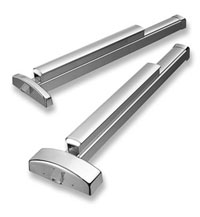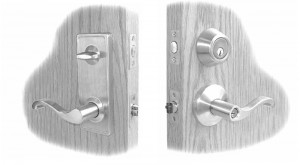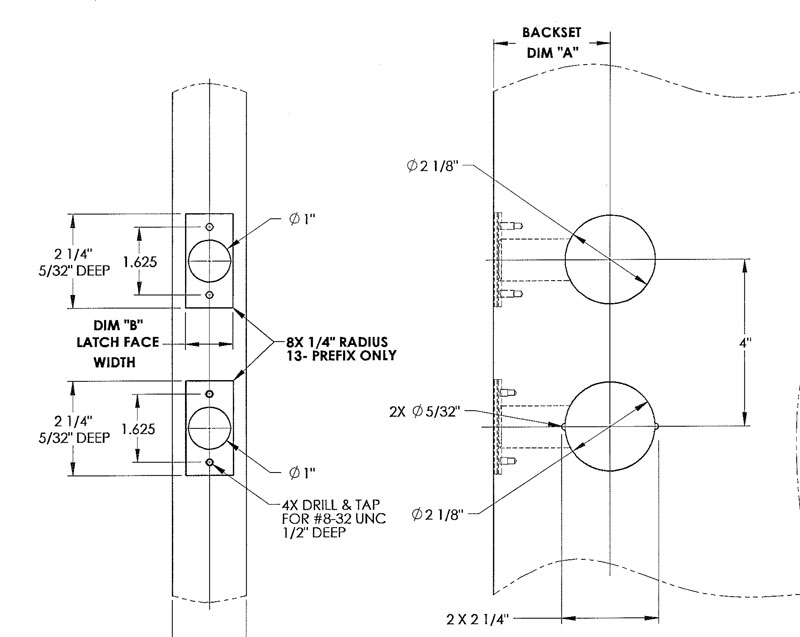Introduction
The terms “crash bar”, “panic hardware” and “exit device” all mean the same thing.

Precision Apex 2000 Series Rim Exit Devices by Stanley
Exit devices are used on doors in the path of egress in buildings built to accomodate numbers of people. Facilities like schools, hospitals, goverment buildings and large residential buildings all use them. Fire rated exit devices are used on fire rated doors. Most interior doors that require exit devices, especially stairwell doors, are fire rated.
Fire Rated Exit Devices
Fire rated openings require fire rated exit devices. Fire rated devices are so designated by Underwriters Laboratories. I am told that UL tests them by mounting the device on a fire rated door and setting the door on fire, letting it burn for a time, and then blasting the door full blast with a fire hose. If the door opens, the device fails the test and cannot be sold as a fire rated exit device.
Non-fire-rated exit devices are used mainly on exterior doors.
Dogging Feature
One of the chief differences between a fire rated exit device and a non-fire-rated exit device is called the “dogging” feature. A dogging feature allows the user to “dog the bar down” using a hex wrench or standard key, leaving the door unlatched. Since fire rated devices must always postitively latch, they never have a dogging feature.
Narrow Stile Exit Devices
The term, “lock stile”, refers to the part of a panel door or aluminum-and-glass storefront door onto which an exit device or other lock is installed. Many aluminum storefront doors one encounters in the world have lock stiles only 1-3/4 inches to 2 inches wide. If you need an exit device for such a door, you need an exit device for a narrow stile application.
Exit Device Types
The four main types of exit devices are:
- Rim
- Mortise
- Surface Vertical Rod
- Concealed Vertical Rod
- Mid-panel
See examples of rim exit devices at:
http://www.sargentlock.com/products/product_overview.php?item_id=86
and
http://www.sargentlock.com/products/product_overview.php?item_id=57
See an example of a surface vertical rod device at:
http://www.sargentlock.com/products/product_overview.php?item_id=56
See an example of a mortise exit device at:
http://www.sargentlock.com/products/product_overview.php?item_id=59
See an example of a concealed vertical rod exit device at:
http://www.sargentlock.com/products/product_overview.php?item_id=60
Specifying Exit Devices
Exit device choice is based upon the door. As mentioned previously
if the door is fire rated, the exit device must also be fire rated.
If the door is a narrow stile door, an narrow stile application exit
device is required.
In addition, you need to know the width of the door. Exit devices
come in different lengths to accomodate different door widths, so
that the touchpad of the exit device provides the coverage required
by national and local life safety and/or fire code. Door thickness
could also be a factor, especially if you are going to need exit device
trim, that is, a lever, doorknob or thumbpiece that allows people
to unlatch the door and enter from the outside. I will discuss exit
device trim shortly.
For a pair of doors (otherwise known as a double opening, or a set
of double doors), the best choice is usually a surface or concealed
vertical rod exit device. In this case you also need to know the door
height.
It is possible to lock a pair of doors using one rim or mortise exit
device and either a vertical rod exit device or a set of flush bolts,
but these solutions (while perhaps saving a little money) present
other problems. If you use a rim device on the active door, then the
strike (the part you will be mounting on the inactive door to receive
the latch of the rim device) is called quite appropriately a “pocket-ripper”
strike, since it hangs into the opening at pretty much trouser pocket
level. Use of a mortise exit device on the active leaf eliminates
that problem, but it will not work as reliably as would two vertical
rod devices, and would save very little money.
The choice between concealed and surface vertical rod exit devices
should be a simple one. If you are having doors made, have the door
manufacturer install concealed vertical rod exit devices at their
factory. If you are installing a vertical rod device at a job site
on existing doors, then use surface vertical rods.
Concealed vertical rod exit devices are preferable because they are
protected from damage by the door. However, it is an especially skilled
installer who can install one in the field, and at that, it is a time
consuming and difficult job.
Mortise exit devices offer superior durability, and are otherwise
the best choice when retro-fitting an exit device to an existing door
that already has a mortise lock.
Exit Device Trim
The exit device goes on the inside, or interior side of the door,
and exit device trim goes on the outside. Exit device trim is available
in different functions. Below are the most common functions:
- Key locks and unlocks lever handle or thumbpiece. Trim can be
left unlocked for periods of time allowing free entry.
- Key retracts latch. Exit device is always locked from outside,
entry by key only. Not available on some vertical rod exit devices.
- Key unlocks trim only while key is inserted. User turns key, operates
control for entry. Trim is relocked when user removes key.
- Passage function: trim is always unlocked allowing free entry.
- Dummy trim: trim is rigid, usable as a handle to pull the door
open when either the bar is dogged down using the dogging feature
(see above) or when the latch is retracted or the device released
by other means.
Exit Device Options
Exit devices are available with a wide variety of options that increase
their functionality. These include:
- Alarm
- Touchpad or latchbolt monitoring switches
- Electric latch retraction
- Electric dogging
- Delayed egress




